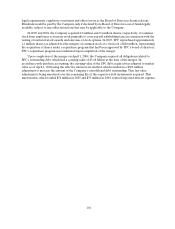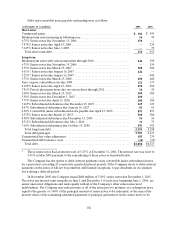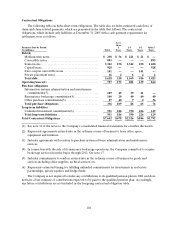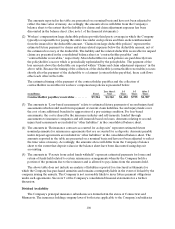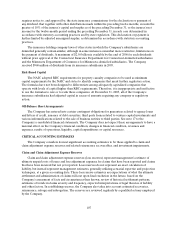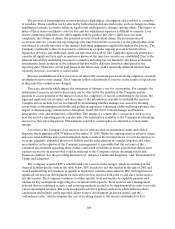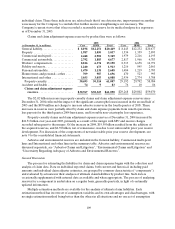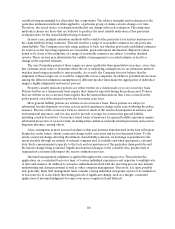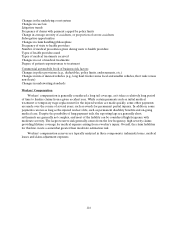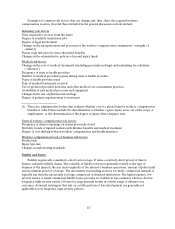Travelers 2005 Annual Report Download - page 122
Download and view the complete annual report
Please find page 122 of the 2005 Travelers annual report below. You can navigate through the pages in the report by either clicking on the pages listed below, or by using the keyword search tool below to find specific information within the annual report.110
variables being meaningful for all product line components. The relative strengths and weaknesses of the
particular estimation methods when applied to a particular group of claims can also change over time.
Therefore, the actual choice of estimation method(s) can change with each evaluation. The estimation
method(s) chosen are those that are believed to produce the most reliable indication at that particular
evaluation date for the claim liabilities being evaluated.
In most cases, multiple estimation methods will be valid for the particular facts and circumstances of
the claim liabilities being evaluated. This will result in a range of reasonable estimates for any particular
claim liability. The Company uses such range analyses to back test whether previously established estimates
for reserves at the reporting segments are reasonable, given subsequent information. Reported values
found to be closer to the endpoints of a range of reasonable estimates are subject to further detailed
reviews. These reviews may substantiate the validity of management’s recorded estimate or lead to a
change in the reported estimate.
The exact boundary points of these ranges are more qualitative than quantitative in nature, as no clear
line of demarcation exists to determine when the set of underlying assumptions for an estimation method
switches from being reasonable to unreasonable. As a result, the Company does not believe that the
endpoints of these ranges are or would be comparable across companies. In addition, potential interactions
among the different estimation assumptions for different product lines make the aggregation of individual
ranges a highly judgmental and inexact process.
Property casualty insurance policies are either written on a claims made or on an occurrence basis.
Policies written on a claims made basis require that claims be reported during the policy period. Policies
that are written on an occurrence basis require that the insured demonstrate that a loss occurred in the
policy period, even if the insured reports the loss many years later.
Most general liability policies are written on an occurrence basis. These policies are subject to
substantial loss development over time as facts and circumstances change in the years following the policy
issuance. The use of the occurrence form accounts for much of the reserve development in asbestos and
environmental exposures, and it is also used to provide coverage for construction general liability,
including construction defect. Occurrence based forms of insurance for general liability exposures require
substantial projection of various trends, including future inflation and judicial interpretations and societal
litigation dynamics, among others.
A key assumption in most actuarial analyses is that past patterns demonstrated in the data will repeat
themselves in the future, absent a material change in the associated risk factors discussed below. To the
extent a material change affecting the ultimate claim liability is known, such change is quantified to the
extent possible through an analysis of internal company and, if available and when appropriate, external
data. Such a measurement is specific to the facts and circumstances of the particular claim portfolio and
the known change being evaluated. Significant structural changes to the available data, product mix or
organization can materially impact the reserve estimation process.
Informed management judgment is applied throughout the reserving process. This includes the
application, on a consistent basis over time, of various individual experiences and expertise to multiple sets
of data and analyses. In addition to actuaries, individuals involved with the reserving process also include
underwriting and claims personnel as well as other company management. Therefore, it is quite possible
and, generally, likely that management must consider varying individual viewpoints as part of its estimation
of loss reserves. It is also likely that during periods of significant change, such as a merger, consistent
application of informed judgment becomes even more complicated and difficult.



